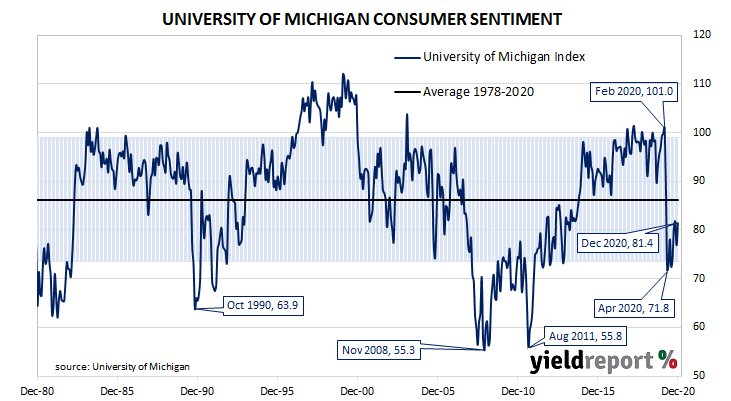Summary: US consumer confidence up in December; University of Michigan index above consensus figure; Democrats voters more optimistic, Republicans less optimistic; “independents” neutral; economic prospects viewed more favourably overall.
US consumer confidence started 2020 at an elevated level. However, by March, surveys had begun to reflect a growing uneasiness with the global spread of COVID-19 and its reach into the US. After a plunge in April, US household confidence began to recover, albeit in a haphazard fashion.
The latest survey conducted by the University of Michigan indicates the average confidence level of US households recovered from November’s loss, maintaining its somewhat-erratic trend. The University’s preliminary reading from its Index of Consumer Sentiment registered 81.4, above the generally expected figure of 76.3 and higher than November’s final figure of 76.9.
“Consumer sentiment posted a surprising increase in early December due to a partisan shift in economic prospects,” said the University’s Surveys of Consumers chief economist, Richard Curtin. Democrats had become “much more optimistic” while Republicans had become “much more pessimistic”.

The report was released on the same day as November producer price indices and US Treasury bond yields moved a little lower across the curve. By the end of the day, the 2-year Treasury yield had shed 2bps to 0.12%, the 10-year yield had slipped 1bp to 0.90% while the 30-year yield finished 2bps lower at 1.62%.
Curtin noted “self-identified Independents adopted more balanced views, maintaining their economic expectations in December at the same unfavourable levels as when the COVID crisis began nine months ago.” However, he said he was still surprised negative news regarding US infections and deaths “was overwhelmed by partisanship.” An improvement in respondents’ long-term economic outlook was behind the gain in the index.
Less-confident households are generally inclined to spend less and save more; some drop-off in household spending could be expected to follow. As private consumption expenditures account for a majority of GDP in advanced economies, a lower rate of household spending growth would flow through to lower GDP growth if other GDP components did not compensate.

